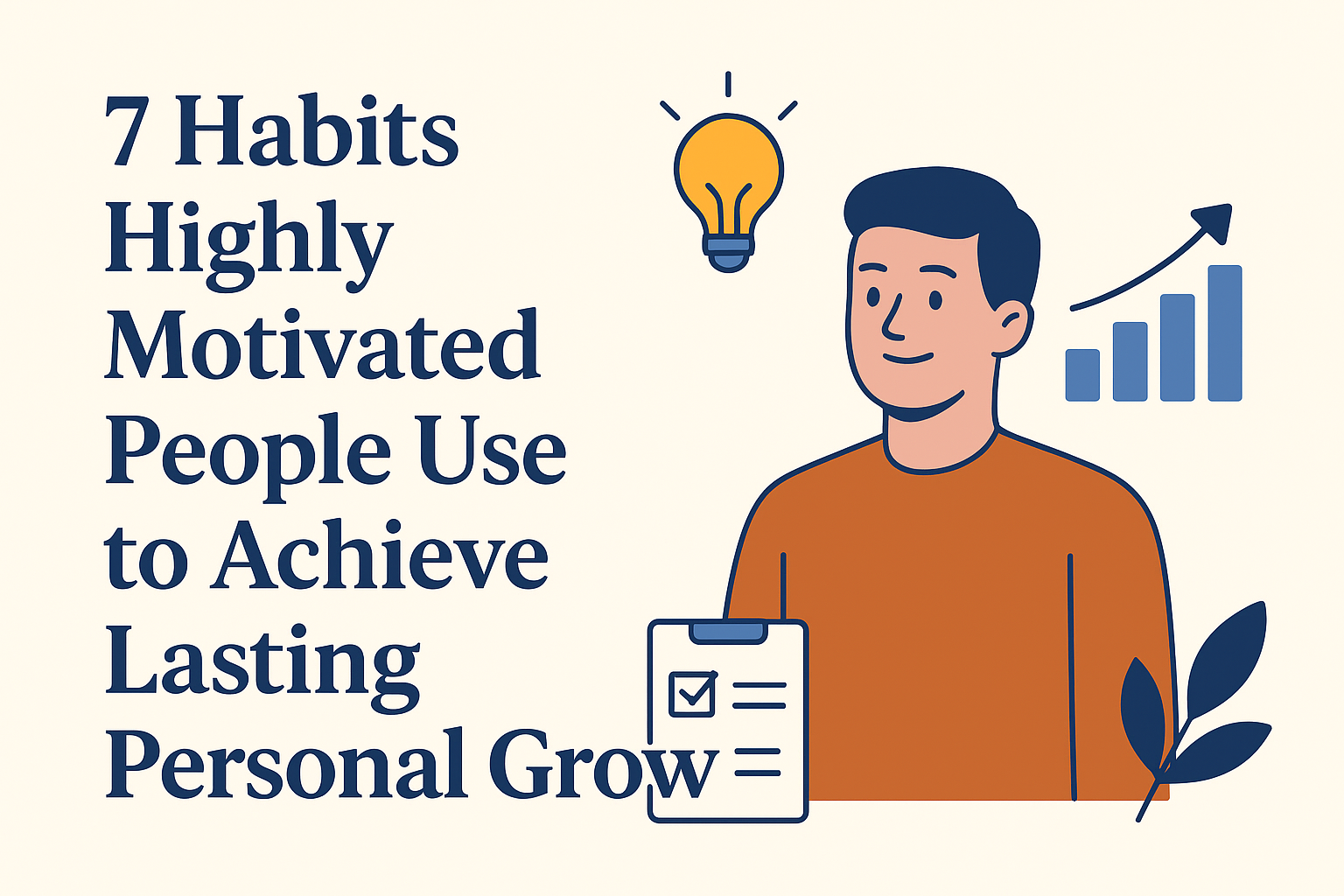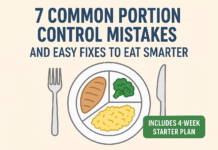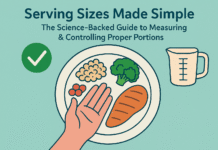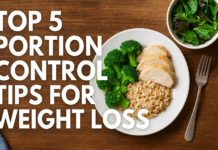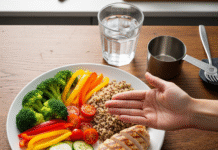Portion control is one of the simplest — and most powerful — habits anyone can adopt to improve weight management, energy, and overall health. Yet it’s also one of the easiest things to get wrong. In this article you’ll learn the seven most common portion-control mistakes people make, why they matter, and clear, practical strategies (with sample mini-plans and a 4-week starter roadmap) to fix them. This is written for busy adults who want realistic, evidence-based ways to eat smarter without turning meals into a chore.
Medical & safety note: This article provides general guidance only. If you have a medical condition (diabetes, kidney disease, pregnancy, eating disorder, or require specialized nutrition), consult a qualified healthcare professional or registered dietitian for personalized advice.
Key takeaways
- Large portions drive overeating: research shows increasing portion size reliably raises how much people eat — sometimes by a third or more.
- Tools beat guessing: a kitchen scale, simple measuring cups, and calibrated plates reliably reduce overserving.
- Mindset matters: slowing down, removing distractions, and eating mindfully reduce “mindless” extra bites.
- Liquids count: drinks can add hundreds of calories without satiety — counting them matters.
- Small, practical swaps add up: plate size, serving from the stove (not the package), and pre-portioning snacks are highly effective habits.
1. Mistake: Relying on food labels or “serving size” as your guide
What it is and why it matters
Package “serving sizes” are standardized for labeling, not necessarily for realistic portion guidance. Manufacturers may list small serving sizes that understate how most people actually eat, or list convenient fractions that encourage multiple servings. Relying on label numbers without checking actual weight or volume can lead to systematic underestimation of calories and nutrients.
Core benefit of fixing this: Understanding true portions helps you manage energy intake and make changes that stick.
Requirements / low-cost alternatives
- Recommended tools: kitchen scale (accurate and inexpensive), measuring cups/spoons, and a simple food-logging app (optional).
- Low-cost alternative: use hand-size portions (palm for protein, cupped hand for carbs, fist for vegetables) and familiar household measures (a tennis ball ≈ 1 cup for many foods).
Step-by-step instructions
- Buy a small digital kitchen scale (reads grams/ounces).
- Weigh common packaged items (e.g., cereal, peanut butter, crackers) to see what a true “serving” looks like. Record the weights for future reference.
- Compare label serving size to what you normally pour — if you consistently pour more, adjust expectations or measure out servings.
- If you can’t weigh, use measuring cups to portion onto a plate before eating.
Beginner modifications & progressions
- Beginner: Measure one meal per day for a week (breakfast or snack).
- Progression: Move to weighing components at two meals per day, then all meals once you’re comfortable.
Recommended frequency / metrics
- Frequency: Start by measuring 3–7 days to build awareness; then spot-check once or twice weekly.
- Metric to track: Portion-awareness score (0–10) — how confident you feel estimating portions without tools.
Safety, caveats, common mistakes
- Don’t get obsessive: aim for practical consistency rather than perfection.
- Weighing cooked vs raw foods differs (e.g., rice absorbs water); learn which to weigh for your recipes.
Sample mini-plan (2–3 steps)
- Buy a kitchen scale.
- For three days, weigh your breakfast components and write down the true portion sizes.
- Adjust future servings to the measured amounts.
2. Mistake: Eating directly from the package or family-style platters
What it is and why it matters
Eating straight from the bag, box, or large serving dish removes natural stopping cues (a finished plate) and provokes mindless nibbling. People routinely eat far more when food is continuously available and visible.
Core benefit of fixing this: Reduces automatic extra calorie intake and helps you notice fullness cues.
Requirements / low-cost alternatives
- Tools: small bowls, plates, resealable containers, or portioned snack bags.
- Low-cost: use a cereal bowl or glass as your “portion station”; put the package away.
Step-by-step instructions
- Before you eat, serve yourself the amount you plan to consume onto a plate or bowl.
- Put the open package away out of sight (in a drawer, cupboard, or another room).
- If someone offers second helpings, wait 10 minutes before deciding — you may already feel full.
Beginner modifications & progressions
- Beginner: Start by plating snacks instead of grazing from the bag.
- Progression: Apply the same habit to family-style dinners and celebrations.
Recommended frequency / metrics
- Frequency: Make this the default every time you snack or eat at home.
- Metric: Count the number of meals/snacks per week where you served from a plate vs package.
Safety, caveats, common mistakes
- Don’t serve unrealistic “diet” portions that leave you hungry and trigger overeating later. Balance portions with protein/veg for satiety.
Sample mini-plan (2–3 steps)
- For seven days, every time you snack, place the portion into a small bowl and put the original packaging away.
- Track how many snacks you finish vs. stop midway — notice differences in fullness.
3. Mistake: Using oversized plates, bowls, and glasses
What it is and why it matters
Visual cues strongly influence how much we eat. Bigger plates and bowls create the illusion of a small portion, prompting people to add more food. Studies show portion and plate size often change intake substantially.
Core benefit of fixing this: Visual trickery works in your favor — smaller dishes = smaller habitual portions with less effort.
Requirements / low-cost alternatives
- Recommended: standard salad plates (around 8–9 inches), smaller bowls, and medium-sized glasses for drinks.
- Low-cost: use dessert plates for meals, or put a smaller plate on top of a larger plate as a trick.
Step-by-step instructions
- Check your plate sizes at home. If dinner plates are 11–12 inches, switch to 9-inch plates for regular meals.
- Serve food on the smaller plate and avoid refilling unless genuinely hungry.
- Use narrower glasses for juice/alcohol to limit poured volume.
Beginner modifications & progressions
- Beginner: Replace one daily meal plate with a smaller plate for a week.
- Progression: Make smaller plates your default for all meals at home.
Recommended frequency / metrics
- Frequency: Always use your smaller plates for planned meals.
- Metric: Measure the difference in meal calories (optional) or the number of times you automatically reach for seconds.
Safety, caveats, common mistakes
- If you switch to a smaller plate but fill it with energy-dense foods (e.g., lots of nuts, cheese), you can still overconsume. Balance matters.
Sample mini-plan (2–3 steps)
- Swap your dinner plate for a salad plate for two weeks.
- Fill half the plate with vegetables, one-quarter with lean protein, one-quarter with starch.
4. Mistake: Eyeballing portions instead of measuring
What it is and why it matters
“Eyeballing” is guesswork. People routinely underestimate portions — often by 20–50% for calorie-dense foods. Small daily underestimates add up to significant excess calories over time.
Core benefit of fixing this: Greater accuracy creates reliable calorie control and helps you learn what true servings look like.
Requirements / low-cost alternatives
- Tools: kitchen scale and set of measuring cups/spoons; calibrated plates or portion-control plates are optional.
- Low-cost alternative: learn simple visual cues (palm, fist, thumb) to estimate portions when tools aren’t available.
Step-by-step instructions
- Learn three visual rules: palm = protein (~3–4 oz), fist = 1 cup (vegetables or carbs), thumb = 1–2 tbsp (oils, nut butter).
- Use a scale for at least one week to connect the visual cues to real weights.
- Create a cheat-sheet (hand-size equivalents and common food weights) and keep it in the kitchen.
Beginner modifications & progressions
- Beginner: Measure only high-calorie or confusing foods (nuts, oils, cheese).
- Progression: Gradually measure whole meals until you can estimate well without tools.
Recommended frequency / metrics
- Frequency: Measure daily until confident; then spot-check.
- Metric: Track estimation error (e.g., percent difference between your estimate and the weighed amount) for learning.
Safety, caveats, common mistakes
- Measuring every single meal long-term isn’t necessary for everyone. Use it as an educational tool to form better habits.
Sample mini-plan (2–3 steps)
- For seven days, weigh nuts, oils, cheese, and cereal at snack time and record weights.
- After a week, try estimating those portions without the scale and check accuracy.
5. Mistake: Ignoring liquid calories (drinks, smoothies, coffee add-ins, alcohol)
What it is and why it matters
Drinks can contain substantial calories but often produce weak satiety signals, so they don’t reduce subsequent food intake. Sugary drinks, alcoholic beverages, and calorie-dense smoothies can add hundreds of calories a day without you noticing.
Core benefit of fixing this: Cutting or replacing even one caloric drink per day can produce meaningful calorie reductions and improved metabolic risk.
Requirements / low-cost alternatives
- Tools: a measuring cup for homemade drinks; read labels for bottled beverages.
- Low-cost alternative: swap with water, unsweetened sparkling water, or black coffee/tea.
Step-by-step instructions
- Audit your daily drinks for one week: write down what and how much you drink (include coffee syrups, milk in lattes, juice, alcohol).
- Identify one high-calorie drink to reduce or replace (e.g., one soda or latte per day).
- Replace the chosen drink with water, sparkling water, or a lower-calorie alternative.
Beginner modifications & progressions
- Beginner: Swap half of a sugary drink with sparkling water for a week.
- Progression: Replace daily caloric drink entirely, or limit alcohol to specified days.
Recommended frequency / metrics
- Frequency: Track drinks daily until a new routine is automatic.
- Metric: Calories-from-drinks per day.
Safety, caveats, common mistakes
- Beware of packaged “healthy” smoothies or juices that are high in sugar. Homemade smoothies should include fiber and protein to increase satiety.
Sample mini-plan (2–3 steps)
- For seven days, log every drink and its size.
- Choose one drink to replace (e.g., afternoon soda → sparkling water) and do so for the next week.
6. Mistake: Mindless eating — multitasking, stress, or eating while distracted
What it is and why it matters
Eating while working, watching TV, or scrolling reduces attention to food and fullness cues. This often increases intake and reduces satisfaction with the meal, making it more likely you’ll snack soon after.
Core benefit of fixing this: Mindful eating improves awareness of hunger and fullness, usually lowering intake and improving enjoyment.
Requirements / low-cost alternatives
- Tools: timer (or set aside 15–20 minutes), bowl/plate, and a quiet spot.
- Low-cost: simply put away screens during meals or use a “no devices” rule for mealtime.
Step-by-step instructions
- Create a mealtime ritual: sit at the table, put your phone away, and take three deep breaths before eating.
- Chew deliberately: aim for at least 20–30 chews per bite (or put cutlery down between bites).
- Pause mid-meal: after half the plate, pause for 60–90 seconds to check fullness.
Beginner modifications & progressions
- Beginner: Start with one mindful meal per day (e.g., evening dinner).
- Progression: Move to all meals being mindful and add short mindfulness mini-practices before eating.
Recommended frequency / metrics
- Frequency: Start with 1 mindful meal daily, increase gradually.
- Metric: Number of mindful meals per week.
Safety, caveats, common mistakes
- Mindful eating can be challenging in busy households. Even short, consistent practice yields benefits.
Sample mini-plan (2–3 steps)
- For seven nights, eat dinner without screens and put utensils down between bites.
- After each meal, rate fullness on a 1–5 scale to track awareness.
7. Mistake: Treating “portion” and “serving” as the same for every purpose (not adjusting for goals or activity)
What it is and why it matters
A “serving” listed on a package or guideline is generic; your needs vary by age, sex, body size, and activity level. Using one-size-fits-all portions can mean underfeeding active people or overfeeding those aiming to lose weight.
Core benefit of fixing this: Tailoring portions to your goals helps you make sustainable progress without unnecessary restriction.
Requirements / low-cost alternatives
- Tools: a simple calorie/fitness tracker (optional) or a baseline activity log to estimate needs.
- Low-cost: use hand-size portions and adjust based on activity (add a palm-sized protein after a long workout).
Step-by-step instructions
- Decide your short-term goal (maintain, lose slowly, or gain muscle).
- Adjust portion rules: for weight loss, reduce starchy/carbohydrate portions slightly and increase vegetables; for muscle gain, increase protein portions by a palm-size serving at key meals.
- Monitor results weekly and fine-tune portions by small amounts.
Beginner modifications & progressions
- Beginner: Implement simple swaps (extra veg, smaller carb portions) and observe appetite/energy for two weeks.
- Progression: If progress stalls, track intake and activity for a week to quantify necessary adjustments.
Recommended frequency / metrics
- Frequency: Reassess portions every 1–2 weeks when changing activity or goals.
- Metric: Weight, energy, sleep quality, or performance in workouts.
Safety, caveats, common mistakes
- Extreme portion restriction can harm metabolism and mental health. Aim for moderate, sustainable adjustments.
Sample mini-plan (2–3 steps)
- Identify goal (e.g., lose ~0.25–0.5 kg per week).
- For two weeks, reduce portion of high-calorie foods by ~10–15% and increase vegetables.
- Reassess and adjust.
Practical add-ons
Quick-start checklist (use immediately)
- Buy or borrow a kitchen scale.
- Swap to a smaller dinner plate.
- Pre-portion snacks into single-serve containers.
- Audit one week of drinks.
- Commit to one mindful meal per day.
Warm-up (first week)
- Day 1–2: Measure and weigh one familiar snack.
- Day 3–4: Swap plates for one meal.
- Day 5–7: Log all drinks and serve snacks from bowls.
Troubleshooting / common pitfalls
- “I tried measuring and gave up.” Make measurement educational not punitive — do it for 1–2 weeks to learn visual cues.
- “I get hungry after using smaller plates.” Ensure plates include protein + fiber. If still hungry, add a small extra portion of vegetables or lean protein.
- “Social eating derails me.” Serve a moderate initial portion, and only refill if truly hungry after 10–15 minutes. Be kind to yourself — one meal won’t ruin progress.
How to measure progress
- Primary: How you feel (energy, fullness) and behavioral wins (serving from a plate, reduced snacking).
- Secondary: Objective measures if desired — weight, waist circumference, or food-log average calories. Track weekly, not daily.
4-week starter plan (practical roadmap)
Goal: Build consistent portion-control habits that reduce average daily intake by 10–15% without excessive hunger.
Week 1 — Awareness
- Measure one commonly underestimated food each day (nuts, cereal, cheese).
- Replace one caloric drink per day with water.
- Use a smaller plate for dinner.
Week 2 — Habit formation
- Pre-portion snacks into single-serve containers for all snack occasions.
- Practice one mindful meal daily (no screens, slow eating).
- Continue smaller plates and measure at least 3 meals.
Week 3 — Refinement
- Add a kitchen scale for at least two meals (weigh proteins and starchy carbs).
- Audit any social or travel eating situations and plan portions ahead (e.g., eat a small snack before going out).
- Record one week of portions vs perceived fullness to tune portions.
Week 4 — Maintenance
- Apply hand-size rules confidently at most meals; weigh occasionally to recalibrate.
- Set a sustainable weekly goal (e.g., 5 mindful meals/week, two drinks swapped).
- Reassess weight or performance metrics and adjust portions accordingly.
FAQs
1. How strict do I need to be with portions to see results?
You don’t need perfection. Small, consistent reductions (around 10–20% of usual portion sizes) combined with better food choices typically produce meaningful results over weeks.
2. Are measuring cups enough, or do I need a scale?
Measuring cups help, but a kitchen scale is the most accurate, especially for calorie-dense foods and recipes that change volume when cooked.
3. How do I handle portion control at restaurants?
Share a meal, order a starter as a main, ask for a to-go box and portion half before eating, or choose dishes with more vegetables and lean protein.
4. Will smaller plates make me feel deprived?
If meals are balanced (protein, fiber, healthy fats), smaller plates generally don’t leave you hungry. Add low-calorie vegetables if needed.
5. Is intermittent fasting a part of portion control?
They’re different tools. Intermittent fasting focuses on timing; portion control focuses on amounts. You can combine both if it suits you, but prioritize sustainability.
6. How do I estimate portions while traveling?
Use hand-size rules, pre-pack snacks, and choose simpler meals (grilled protein + salad) when possible.
7. Can portion control help with conditions like high blood sugar or high blood pressure?
Yes—controlling portions, especially of high-calorie/sugar foods, helps with weight and metabolic control. For specific medical conditions, consult your healthcare provider.
8. How long before I notice changes?
Behavior and satiety changes can appear within days to weeks. Weight or body changes usually take several weeks; track trends not daily fluctuations.
9. Are portion-control plates effective?
Portion-control plates and calibrated plates can help many people by providing visual cues and have been linked to improved portion awareness.
10. What’s the best single habit for portion control?
Serve food onto a plate or bowl (not from the package) and remove the package immediately. This one habit reduces mindless extra eating.
11. Can I use portion control for muscle gain?
Yes—portion control is about matching intake to goals. Increase protein portions (palm-sized servings) and overall intake slightly while monitoring progress.
12. Is weighing food necessary for long-term maintenance?
Not always. Many people use weighing as an education phase, then rely on visual estimates and consistent habits for maintenance.
Conclusion
Portion control isn’t about deprivation — it’s about aligning what you eat with your goals through small, sustainable choices. Swap one habit at a time (measure, plate, or pause), and you’ll build a system that keeps you satisfied while cutting excess calories. Start with one change this week and make it automatic.
CTA: Try this: swap your dinner plate for a smaller one tonight — notice how you feel afterward.
References
- “Sizing up the Effect of Portion Size on Consumption: A Meta-Analytic Review”, Journal of Marketing, May 2014. https://journals.sagepub.com/doi/full/10.1509/jm.12.0303
- “Downsizing food: a systematic review and meta-analysis examining the effect of reducing served portion sizes on daily energy intake and body weight”, International Journal of Behavioral Nutrition and Physical Activity, 2023. https://www.ncbi.nlm.nih.gov/pmc/articles/PMC9975786/
- “Impact of Portion Control Tools on Portion Size Awareness, Choice and Intake: A Systematic Review”, Nutrients (PMC), 2021. https://www.ncbi.nlm.nih.gov/pmc/articles/PMC8229078/
- “Sugar-sweetened beverages and weight gain in children and adults: a systematic review and meta-analysis”, American Journal of Clinical Nutrition (PMC), 2013. https://www.ncbi.nlm.nih.gov/pmc/articles/PMC3778861/
- “Effects of mindfulness‐based interventions on obesogenic eating behaviours: a systematic review and meta-analysis”, Obesity Reviews (PMC), 2024. https://www.ncbi.nlm.nih.gov/pmc/articles/PMC11791380/
- “Mindful Eating • The Nutrition Source”, Harvard T.H. Chan School of Public Health, 2020 (web page). https://nutritionsource.hsph.harvard.edu/mindful-eating/
- “A new measurement aid that can improve portion size estimation”, British Journal of Nutrition (PMC), 2017. https://www.ncbi.nlm.nih.gov/pmc/articles/PMC5596841/
- “How does plate size affect estimated satiation and intake for food?”, Appetite (PMC), 2017. https://www.ncbi.nlm.nih.gov/pmc/articles/PMC5598018/
- “5 A Day portion sizes”, NHS (web page), 2021. https://www.nhs.uk/live-well/eat-well/5-a-day/portion-sizes/
- “Portion sizes”, British Nutrition Foundation, (web page). https://www.nutrition.org.uk/creating-a-healthy-diet/portion-sizes/
- “Portion Sizes” (patient-facing PDF), NHS Fife, 2021 (PDF). https://www.nhsfife.org/media/seuz0u8c/8-portion-sizes.pdf
- “Kitchen scales are a valuable tool”, Michigan State University Extension, 2016 (web article). https://www.canr.msu.edu/news/kitchen_scales_are_a_valuable_tool
- “Impact of portion-control plates (PCP) on weight reduction”, Obesity Research & Clinical Practice (abstract), 2021. https://www.sciencedirect.com/science/article/abs/pii/S1871403X21000089





